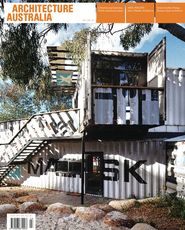More than half the world now lives in urban environments. What does this mean for building sustainable cities? What are the opportunities and responsibilities for Australia? Ceridwen Owen reports on EcoEdge 2.
The EcoEdge 2 Conference, held at Federation Square in Melbourne in February, was the sixth in a series of forums hosted by the City of Melbourne to explore the critical issues in the design of the contemporary metropolis. The specific theme for this year’s conference, “the urgent design challenge in building sustainable cities”, reflects a recent watershed event. For the first time in history, more than half of the world’s population now lives in urban areas.
The 450 delegates, primarily architects, urban planners and state and local government representatives, gathered together over three days to hear a range of local, interstate and international speakers on the sub-themes of green government, green urbanism and green buildings. Presentations varied widely, from the abstract and theoretical to the concrete and particular, and from the scale of the shack to the Chinese megapolis.
Not surprisingly, given the theme for this year’s conference, several presentations examined the unprecedented scale and speed of urbanization in China. To my mind, the most interesting and thought-provoking take on the China situation came from Neville Mars, Director of the Dynamic City Foundation in Beijing. Addressing the socio-cultural as well as the more frequently discussed physical challenges of an urbanizing China, Neville Mars prompted consideration of the move from the “collective dream” of communism to the “scattered dream” of the market. With a government goal to build 400 new cities of one million inhabitants each by 2020, equivalent to the construction of Europe within the next twenty years, how can these new dreams take shape in the mind before they become a physical reality?
The physical patterns that are emerging in the contemporary Chinese city were challenged by several of the presenters who are actively engaged in designing vast precincts within these new urban centres. Urban density (or lack of it) was a particular concern. As Peter Davidson of Lab Architecture Studio pointed out, it is the literal interpretation of the “green city” that is leading to a sprawling urban suburbia with twenty-five percent site coverage. At the same time, Davidson questioned the apparent disparity between Chinese conceptions of holism in relation to the body and the application of mono-functional thinking in the design of the urban realm.
Nevertheless, as Xuemei Bai, Senior Science Leader at CSIRO Sustainable Ecosystems, argued, the fast pace of development in China can just as quickly be turned towards more sustainable practices. The wide-reaching control and influence of the Chinese Government facilitates the implementation of policy and practices in a way that is inconceivable in Australia. For example, the city of Rizhao has seen a 99 percent uptake of solar hot water due to government intervention through industry subsidies, while Dongtan, an island offshore from Shanghai, will be the world’s first “eco-city” with a zero emission target.
In this context, the problems and opportunities of the Australian situation pale into insignificance. In response to the question “What is the biggest contribution Australia can make to sustainability?”, Peter Davidson simply said, “Help China.” Santha Sheela Nair, who heads the Department of Drinking Water Supply in India, also put things into perspective by discussing the problems of sanitation in India, a country growing at the rate of one Australia every year. Nevertheless, as Santha Sheela Nair also argued, the global impact of developed nations such as Australia far outweighs their relative scale. Western precedents are consistently emulated as desirable models of development. This, coupled with the education of many future urban professionals, places a far greater responsibility on the shoulders of this nation.
The Australian urban context received a fair amount of attention at the conference, particularly and most predictably the unsustainability of the suburbs. Very few solutions were offered; rather, there was widespread recognition that currently we lack appropriate alternative models that address the issue of density in our suburbs while acknowledging the desirability of the “suburban dream”. Enrique Peñalosa, former mayor of Bogotá, Columbia, believes that an answer can be found in the design of pedestrian cities where people “can live as human social beings”. As he argues, “cars are to children today what wolves used to be to children in the Middle Ages.” The suburbs offer relatively car-free streets, but ironically the retreat from the traffic congestion of the city itself leads to increasing dependence on the automobile.
Urban sprawl and the densification of the suburbs are most certainly key areas to address in the design of more sustainable and livable cities. However, with the exception of consideration of public transport infrastructure, there is a tendency to view the suburbs in isolation from the broader physical, cultural and sociopolitical context in which they are situated. As a number of presenters pointed out, this is only exacerbated in a three-tiered hierarchical political system that has no mechanism to address the city as a whole (let alone regional systems such as the Murray-Darling basin).
This carving up of space (both physical and political) into discrete pockets is endemic in contemporary society. However, as Kevin O’Brien from Merrima Design eloquently argued in a passionate and moving presentation, it is a condition that needs to be challenged in order to find our “place” or “country”. He said, “Architecture is a potent mechanism that allows us to find country.” However, this necessitates connections beyond the surveyor’s pegs of the “site”.
In one of the last presentations of the conference, Tim Costello, CEO of World Vision Australia, extended the concept of the erosion of boundaries to the realm of the sociopolitical. Promoting the idea of “alignment” as a key condition in addressing global issues of climate change and poverty, he encouraged us to think as global citizens because “a global village demands a global ethic”.
From finding country to finding our place within the world, such sentiments communicate powerful messages. They left me, at least, buoyed with optimism as I left the conference, walking into a beautiful sunny afternoon on the banks of the Yarra River, surrounded by the activities of the Sustainable Living Festival. Another feelgood talkfest? Perhaps, but an inspiring one nonetheless, which provided energy for future debate and action. On that last note, the conference organizers – building on the success of the EcoEdge 1 conference, in which profits were donated to the Sri Lanka tsunami reconstruction effort to construct two mobile libraries and rebuild a school – will donate any profits from this conference to initiatives in Australian Indigenous communities. A little action out of all that talk …
Dr Ceridwen Owen is a lecturer in architecture at the University of Tasmania.















